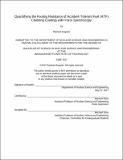Quantifying the fouling resistance of Accident-Tolerant Fuel (ATF) cladding coatings with force spectroscopy
Author(s)
Auguste, Rasheed
DownloadFull printable version (16.65Mb)
Other Contributors
Massachusetts Institute of Technology. Department of Nuclear Science and Engineering.
Advisor
Michael Short.
Terms of use
Metadata
Show full item recordAbstract
CRUD (Chalk River Unidentified Deposits) is buildup of metal oxides on the interior of nuclear reactors. This is caused by corrosion in reactor internals, leading to problems such as coolant contamination in porous deposits left by CRUD. CRUD has forced many nuclear reactors into temporary shutdown or production downgrades, costing millions of dollars US per reactor. If the CRUD growth factors could be fully understood, they could be controlled, and the CRUD problem could be eliminated altogether. Atomic force microscopy can be used to measure the force, or the strength of the CRUD-clad bond with different materials. This research focuses on answering this question: How does the force change between CRUD particles and different materials that could be used for reactor cladding? This study will analyze lab-grown CRUD samples on different substrate materials and characterize CRUD growth on each. It was found the CRUD-bond forces (from least to greatest) on silicon carbide (SiC), Titanium aluminum carbide (Ti2AlC), and max-phase zirconium alloy 211(Zr4M211) behaved similarly in air and in water. The forces on each surface increased with increasing dwell time for the Fe3O4 particle AFM tip; in contrast, most adhesion forces stayed constant with the NiO AFM tip. Furthermore, these CRUD forces were compared to other non-accident tolerant fuels, and there are cases in which non-ATF materials show more CRUD resistance (less adhesive force) than ATF-materials. This study's analysis could be applied to other materials to be used for reactor cladding. Once the material with the lowest-strength CRUD bond is identified and installed, the nuclear industry could save millions of dollars US per reactor fuel cycle.
Description
Thesis: S.B., Massachusetts Institute of Technology, Department of Nuclear Science and Engineering, 2017. This electronic version was submitted by the student author. The certified thesis is available in the Institute Archives and Special Collections. Cataloged from student-submitted PDF version of thesis. Includes bibliographical references (pages 418-420).
Date issued
2017Department
Massachusetts Institute of Technology. Department of Nuclear Science and EngineeringPublisher
Massachusetts Institute of Technology
Keywords
Nuclear Science and Engineering.